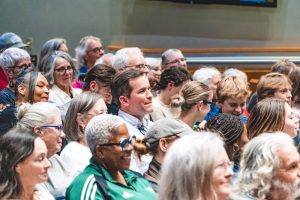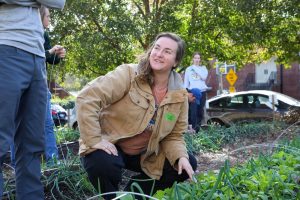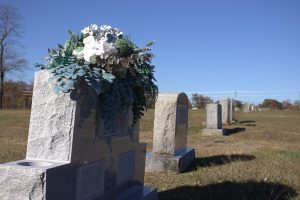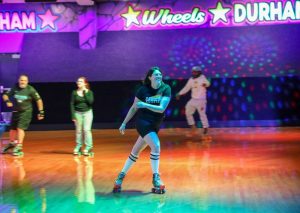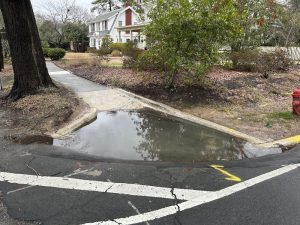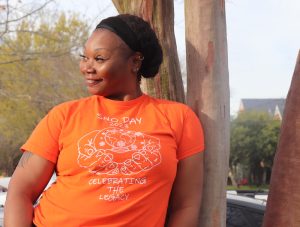At 6 p.m. on March 20, about 30 cyclists gathered near the Shell station at the intersection of West Main, West Morgan, and Watts streets. The event, organized by the nonprofit advocacy group Bike Durham, was part rally, part vigil, and part bike ride to the City Council meeting.
“I’d like to actually start off with a moment of silence to honor those who have lost their lives to traffic violence, and to all those affected by traffic crashes here in Durham,” said Erik Landfreid, the transit equity campaign manager at Bike Durham.
One of those affected people was Noah Goyette, a Durham social worker who showed up to the rally bruised and limping with an arm in a cast.
On March 3, he was riding downhill on West Main Street near Duke University’s East Campus when he moved out of the bike lane to avoid the cars illegally parked outside Insomnia Cookies and Mr. Fries Man. He swerved to avoid a pothole, hit a second pothole, and hit the ground.
“I landed on my chin, my face, both hands, and then my neck folded and I flipped down the road,” he said in an interview with The 9th Street Journal.
His injuries, listed extensively on his gofundme page, read like a laundry list of pain – including bruised ribs, a dislocated shoulder, and hyperextended shoulder blades. He was hospitalized and had reconstructive surgery on his face.
But the injuries didn’t exactly come as a surprise to Goyette. There are often cars parked in that bike lane.

Four months later, he hit the pavement in that exact spot.
At the rally, the moment of silence was briefly interrupted by the clacking of biking cleats on gravel as a cyclist arrived late. But the sound of automobile traffic was nonstop.
“On average a person walking or biking is killed or seriously injured in Durham traffic every 16 days,” said Landfried over the din. “These crashes and tragedies are often called accidents by some in the media, by some in the police, but they are not accidents. These are the result of a transportation system that prioritizes speed over safety, and prioritizes people in cars and trucks over people walking, biking and using the bus.”
One demand of the Bike Durham riders was the appointment of a Vision Zero coordinator.
Vision Zero is an international approach to reducing traffic deaths, based on strategies like adding protected bike lanes and traffic-calming infrastructure. The city adopted a Vision Zero resolution in 2017, but has done little to implement it, Landfried said.
“The City of Durham must do better. And we need to make sure that the city knows that we do not accept these deaths and injuries as a byproduct of our transportation system,” said Landfried.
After a few other speeches, the cyclists gathered where Goyette flew off his bike to prepare to ride together to the City Council meeting.
As they clustered, a food delivery service car pulled up in front of Insomnia Cookies and parked in the bike lane, right in front of the no parking sign. The man who got out to pick up a box of cookies was oblivious to the line of bikers next to his car.
“They’re protesting this,” a woman on foot told him. “Exactly what you’re doing.”
“I’m not mad at gig workers,” Goyette said, looking at the car parked in the same spot that resulted in his recent injuries. “If there were plastic tubes then we won’t have that argument.”
Goyette and others in Bike Durham want protected bike lanes, which use barriers like plastic tubing to separate the lane from automobile traffic.
“A painted line does not a bike lane make,” Goyette said.
Goyette sees changes like protected lanes as preventative care, reducing the amount of city money that needs to be spent later on emergency services when someone like him is injured. “Firefighters came, EMS came, police came, blocked this whole street at 9 p.m. on a Friday. Is that a good financial choice for the city?”
To Goyette, the infrastructure issue is bigger than just protected bike lanes. He couldn’t cycle from Mr. Fries Man to City Hall with the Bike Durham group because of his injuries. On his walk, he paused at the intersection of Chapel Hill Street, West Main Street, and Morris Street before crossing.
“How does anybody know what to do here?” he asked. “I don’t know how people don’t die here every single day.”
A passing driver honked for no clear reason.
One of the people killed in traffic last year was Matthew Simpson, who was hit by a car while biking with his wife and two children. At the City Council meeting, Allison Simpson, his wife, urged the council to listen to Bike Durham’s demands.
“I want to honor Matt’s life and turn my pain into something productive,” she said. “Based on data from the NCDOT 2021 report there has not been a reduction in traffic fatalities and serious injury in Durham since the city adopted Vision Zero. Today I ask that the Durham City Council’s budget reflect a stronger commitment to the Vision Zero in order to make progress toward the goal of zero traffic fatalities and serious injury.”
The council thanked the cyclists for their comments and moved on to other business, including a proposed annexation and rezoning in southeast Durham that attracted strong criticism from some residents. The council approved the annexation and rezoning 4-3.
Afterward the vote, council member Leonardo Williams indicated that he was open to funding Vision Zero, but he wondered about the source of the money.
“We want to fund programs that we know are working,” he said. “We want to fix sidewalks, and we want to make sure we have protected bike lanes. But no one wants us to generate the revenue to get there.”
Above: Cyclists rallied ahead of a recent City Council meeting to demand safer streets. Photos by Chase Pellegrini de Paur — The 9th Street Journal
Chase Pellegrini de Paur


